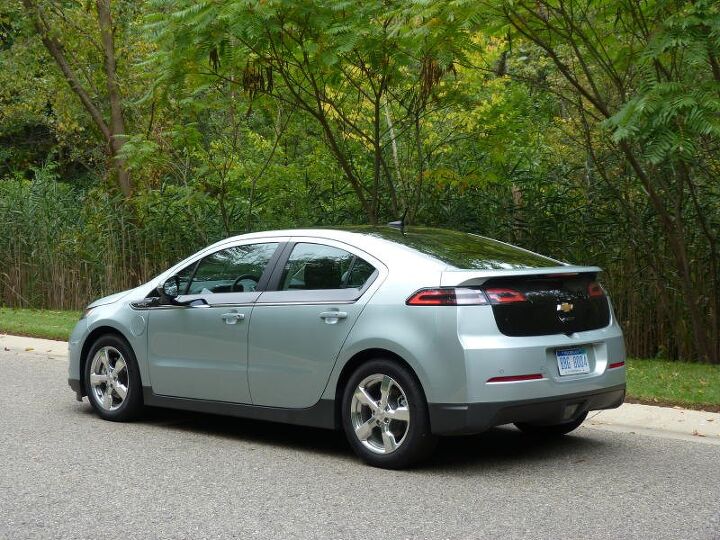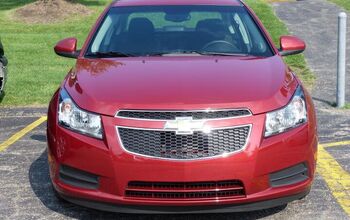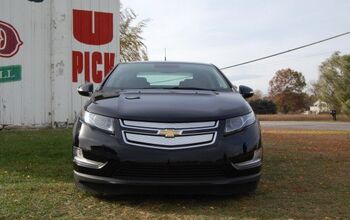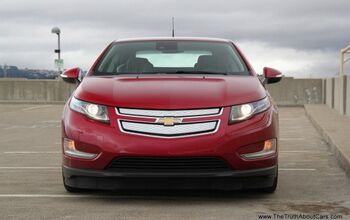Review: Chevrolet Volt Vs. Chevrolet Cruze Eco
Ed, Sajeev, and yours truly have all weighed in on the Chevrolet Volt. We all agreed that it drives surprisingly well, but that aspects of the interior need work. I hadn’t been planning to review the Volt again, but was asked if I’d like to have one for a week following the Cruze ECO. And so an intramural competition was born. If the $19,995 Cruze ECO is such a solid, comfortable, and efficient commuter, why spend twice as much for the $39,995 Volt?
Okay, maybe not twice as much. A $7,500 tax credit takes care of over a third of the difference. And a run through TrueDelta’s car price comparison tool finds that the Volt includes about $2,300 in additional features. Give credit for these, and the difference is about $10,300. So figure fifty percent more.
A word about those earlier reviews. All three were based on short drives, about an hour in my case. More than a few people have wondered how valid such a review can be. Well, valid enough that even after a week in the car I find I have little to say that hasn’t been said before, save that the strengths noted earlier remain strengths and the weaknesses noted earlier remain weaknesses—neither significantly diminishes with experience.
The number one weakness: as Ed noted, “an iPod covered in buttons is no iPod at all.” Even after a week in the car the center stack remained difficult to use. At a minimum the many buttons need to be separated into clearly demarcated logical groups. As is, even basic functions often require far too much conscious thought and time with one’s eyes off the road. I never did figure out how to best operate the HVAC, as the AC and heating systems seemed to have minds of their own even in “comfort” mode. I’d also like a way to turn off the audio without turning off everything. As is, you either have to turn the volume all the way down or use the mute button on the steering wheel. Go the latter route, and the music returns at the original volume the next time the car is started—the “mute” is forgotten when the car is shut off.
Among other weaknesses, the Volt’s rear seat didn’t seem any less cramped after a week with the car than it did initially. And you’ll want the $695 rear camera option given the car’s poor rearward visibility.
Objectively, the Volt’s number one strength is, of course, its ability to run on electricity. Some will claim that the roughly forty-mile range before the gas-powered “range extender” automatically kicks on isn’t sufficient. Well, in my case I had to take the car off life support in order to test it with the engine running. Until I did so all of my runs to Costco, the doctor (daughter broke a toe), and the kids’ school were accomplished entirely on battery power.
How much cheaper is it to run on electricity? I complained earlier that the Volt’s display doesn’t include a report for miles-per-kWh analogous to the trip computer’s miles-per-gallon report while running on gas. I’ll repeat that complaint. Consequently, I had to do a little math, the upshot of which is that the Volt covers about four miles on each kilowatt-hour (when not running the air conditioning). Conservatively figure three miles per kWh to allow for charging losses and some AC use. In Michigan each kWh costs about 12 cents, so this works out to about four cents per mile. In the Cruze ECO I observed a bit over 35 MPG. With gas at $3.80, that’s about 11 cents per mile. Over the course of a 12,000-mile year, the difference would add up to about $800. In other words, it’ll be a while before that $10,000+ is recouped.
But does this render the Volt pointless? Perhaps there’s more to the car than cutting fuel costs? Any car beyond a basic transportation appliance is bought because it’s more pleasurable to look at, sit in, or drive. Perhaps all three.
The production Volt doesn’t look like the initial concept (which I personally never expected to happen, given GM’s propensity to create thoroughly impractical concepts). But it also doesn’t look like the Cruze or anything else, with the partial exception of the Prius. And it does have a more stylish, upscale exterior than the Prius. Just looking at it I felt like I was driving something special, and not just because of the $995 “veridian joule” paint and $595 polished aluminum wheels that helped bump the pre-tax credit total to $46,165 (someone inside GM did their best to induce sticker shock in reviewers). This was far from the case with the Cruze.
Sit in the Volt, and the sense of occasion goes up by an order of magnitude. Love it—or not—the interior styling is certainly distinctive and effectively expresses the leading-edge technology packed into the car. When pressed, the start button lights up blue while the car makes a video game-like “powering up” sound. Hit it again, and you get a “powering down” sound as the light goes out. (My boys loved this.) The problem we had figuring out whether or not the Prius was on: avoided. The two displays are gorgeous and far better designed than the buttons that assist them. The driving efficiency gauge, a ball the changes height and color, is the most intuitive I’ve yet experienced—though I wish it reported how much of the braking was being handled through the regenerative system. There’s also a driving efficiency report to surreptitiously test one’s “I’m not going to change the way I drive” spouse. (She scored a respectable 86 percent and reported liking the car far more than the relatively sluggish Prius.)
Drive the Volt, and you’ll find that, in this case at least, appearances aren’t deceiving. GM has tuned the powertrain to deliver an incredibly smooth launch. Even if you floor the accelerator from a dead stop in “sport” mode there’s not a hint of a jerk. You cannot chirp a tire in this car. Instead, the car smoothly and almost silently builds speed much the way a high-speed elevator does (if not in the same direction). As with the Prius, driving the Volt with an ultra-light foot feels natural. But, unlike with the Prius, driving it with a heavy foot also feels right. Once the car is underway the electric motor dishes out a firmer shove when prodded. Either way, the Volt never feels sluggish or strained the way a Prius (or Cruze ECO, for that matter) can. With the accelerator to the floor the car easily leaves traffic behind—if you’re in a hurry, sixty can happen in about nine seconds. Not a stellar time, but recall that this is with absolutely no sign of strain from the powertrain. While running on battery power the electric motor is nearly silent. I rode in an EV1 once, and the whine of its motor was far louder. Run out of battery and the Volt’s 1.4-liter gas engine automatically cuts on, but usually remains a distant hum while roughly matching the MPG of the Cruze (high 20s to mid 40s, depending on driving style and conditions, with a suburban average around 35), and so 10-12 MPG short of a Prius. At its loudest the gas engine remains far quieter than the 1.8 recently sampled in the new Chevrolet Sonic. If GM can achieve such silent running in the Volt, why not in the Sonic? Braking is also smooth and silent in the Volt, with no evident transition between the regenerative system and the conventional brakes. The entire experience of driving the car is distinctively effortless, almost magical.
This isn’t to say that the Volt is a cocoon. The suspension is firmer and more tightly damped than that in the Cruze ECO and there doesn’t seem to be as much road noise insulation. As a result, impacts are more sharply felt and heard, but body motions are also better controlled. The ride remains comfortable, and serious drivers will appreciate the chassis’s moderate level of feedback, which helps compensate for the incommunicative (if well-weighted) steering.
The bottom line: I wasn’t sad to see the Cruze ECO go at the end of the week—it’s a very well done appliance, but an appliance nonetheless—while I very much miss driving the Volt. In twenty years the way the Volt drives will likely seem typical, but we’re not nearly there yet. In the here and now the Volt’s worth $10,000+ more than the Cruze the same way other $30,000+ cars are worth more than the Cruze: by providing a different, more desirable experience.
Chevrolet provided the vehicle, insurance and fuel for this review.
Michael Karesh operates TrueDelta, an online source of automotive pricing and reliability data.
Michael Karesh lives in West Bloomfield, Michigan, with his wife and three children. In 2003 he received a Ph.D. from the University of Chicago. While in Chicago he worked at the National Opinion Research Center, a leader in the field of survey research. For his doctoral thesis, he spent a year-and-a-half inside an automaker studying how and how well it understood consumers when developing new products. While pursuing the degree he taught consumer behavior and product development at Oakland University. Since 1999, he has contributed auto reviews to Epinions, where he is currently one of two people in charge of the autos section. Since earning the degree he has continued to care for his children (school, gymnastics, tae-kwan-do...) and write reviews for Epinions and, more recently, The Truth About Cars while developing TrueDelta, a vehicle reliability and price comparison site.
More by Michael Karesh
Latest Car Reviews
Read moreLatest Product Reviews
Read moreRecent Comments
- ToolGuy I might be Batman.
- Lou_BC Well, I'd be impressed if this was in a ZR2. LOL
- Lou_BC This is my shocked face 😲 Hope formatting doesn't fook this up LOL
- Lou_BC Junior? Would that be a Beta Romeo?
- Lou_BC Gotta fix that formatting problem. What a pile of bullsh!t. Are longer posts costing TTAC money? FOOK












































Comments
Join the conversation
Very good review. I think Chevrolet did a good job hiding the utilitarian compromises in the styling with one exception. On the bottom where there is the blackout strip, the blackout strip doesn't extend onto the doors. The result is it looks like the doors from another car were tacked onto the Volt. Since this car had a premium paint package to the tune of $995, it seems especially shoddy. As to the $7500 tax credit: it is a subsidy to get the technology further up the technology curve (experience curve) faster. In the experience curve, the costs of production decrease in proportion to cumulative units produced. Absolutely it is a subsidy, but we actually subsidize all cars because the gas tax doesn't pay the whole cost of maintaining our road system, nor does it account for the external effects of the pollution the cars generate.
Regarding the tax subsidy, electric cars in general are very much a chicken and egg issue for infrastructure and consumer acceptance. Without the subsidy it seems pretty unlikely GM would produce the Volt, and adoption of fuel-efficient electric cars would be much delayed in the US. The fact that the subsidy is apparently quite effectively facilitating the move into electric cars -- which will eventually allow Americans to ship boatloads less money in exchange for foreign oil -- strikes me as an amazing bargain and good use of government funding. And it's exactly the kind of thing governments are intended to do: look after the strategic long- term interests of the republic when ordinary market-driven choices of American citizens would be penny wise and pound foolish. Good on GM for at least moving things forward for a change after 40 years of fighting progress. In a few years when the production costs of Volt-like hardware drop to around $20k rather than the current $40k the role of the subsidies (like the effective tax subsidies that created the interstate system in the 50s and 60s) will be considered as an obvious win when it is remembered at all. In spite of the current fashionable trendiness of detesting government meddling, it's responsible for creating most of the auto centric world we live in.